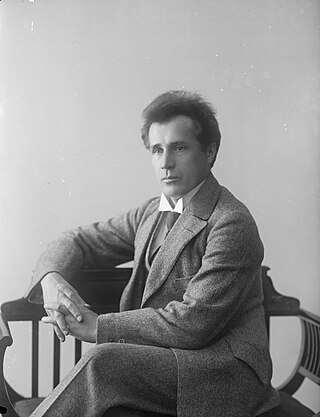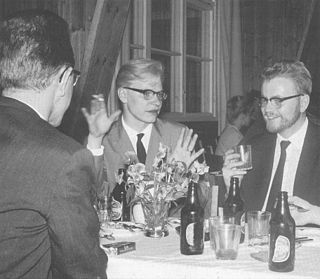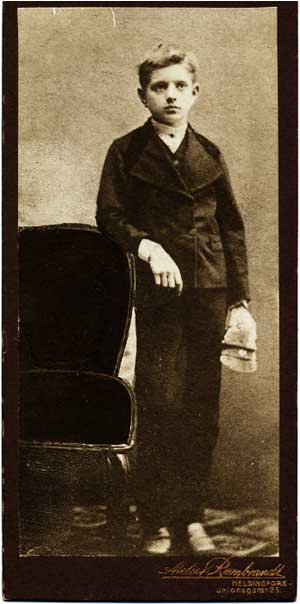Related Research Articles

Jean Sibelius was a Finnish composer of the late Romantic and early-modern periods. He is widely regarded as his country's greatest composer, and his music is often credited with having helped Finland develop a stronger national identity when his country was struggling from several attempts at Russification in the late 19th century.

Edwin Olin Downes, better known as Olin Downes, was an American music critic, known as "Sibelius's Apostle" for his championship of the music of Jean Sibelius. As critic of The New York Times, he exercised considerable influence on musical opinion, although many of his judgments have not stood the test of time.

Leevi Antti Madetoja was a Finnish composer, music critic, conductor, and teacher of the late-Romantic and early-modern periods. He is widely recognized as one of the most significant Finnish contemporaries of Jean Sibelius, under whom he studied privately from 1908 to 1910.

Aino Ackté was a Finnish dramatic soprano. She was the first international star of the Finnish opera scene after Alma Fohström, and a groundbreaker for the domestic field.

Erkki Olavi Salmenhaara was a Finnish composer and musicologist.

Kullervo, Op. 7, is a five-movement symphonic work for soprano, baritone, male choir, and orchestra written from 1891–1892 by the Finnish composer Jean Sibelius. Movements I, II, and IV are instrumental, whereas III and V feature sung text from Runos XXXV–VI of the Kalevala, Finland's national epic. The piece tells the story of the tragic hero Kullervo, with each movement depicting an episode from his ill-fated life: first, an introduction that establishes the psychology of the titular character; second, a haunting "lullaby with variations" that portrays his unhappy childhood; third, a dramatic dialogue between soloists and chorus in which the hero unknowingly seduces his long-lost sister; fourth, a lively scherzo in which Kullervo seeks redemption on the battlefield; and fifth, a funereal choral finale in which he returns to the spot of his incestuous crime and, guilt-ridden, takes his life by falling on his sword.

En saga, Op. 9, is a single-movement tone poem for orchestra written from 1891 to 1892 by the Finnish composer Jean Sibelius. The piece, which likely began as a septet or octet for flute, clarinet, and string ensemble before evolving into an orchestral tone poem, premiered on 16 February 1893 in Helsinki with Sibelius conducting the Helsinki Orchestral Association. A decade later in 1902, Sibelius substantially revised En saga in response to an invitation from Ferruccio Busoni to conduct the piece in Berlin. It thus stands alongside The Lemminkäinen Suite (Op. 22), the Violin Concerto (Op. 47), The Oceanides (Op. 73), and the Fifth Symphony (Op. 82) as one of the most overhauled works in his œuvre. The Berlin concert, which occurred a fortnight after Robert Kajanus had premiered the revised version in Helsinki on 2 November, finally brought Sibelius the German breakthrough he had long desired.

Robert Kajanus was a Finnish conductor, composer, and teacher. In 1882, he founded the Helsinki Orchestral Society, Finland's first professional orchestra. As a conductor, he was also a notable champion and interpreter of the music of Jean Sibelius.

The Building of the Boat was a projected Wagnerian opera for soloists, choir, and orchestra that occupied the Finnish composer Jean Sibelius from 8 July 1893 to late-August 1894, at which point he abandoned the project. The piece was to have been a collaboration with the Finnish author J. H. Erkko, whose libretto adapted Runos VIII and XVI of the Kalevala, Finland's national epic. In the story, the wizard Väinämöinen tries to seduce the moon goddess Kuutar by building a boat with magic; his incantation is missing three words, and he journeys to the underworld of Tuonela to obtain them. In July 1894, Sibelius attended Wagner festivals in Bayreuth and Munich. His enthusiasm for his own opera project waned as his attitude towards the German master turned ambivalent and, then, decisively hostile. Instead, Sibelius began to identify as a "tone painter" in the Lisztian mold.

Arvid Järnefelt was a Finnish judge and writer.

The Maiden in the Tower, JS 101, is an opera in one act—comprising an overture and eight scenes—written in 1896 by the Finnish composer Jean Sibelius. The piece was a collaboration with the Finnish author Rafael Hertzberg, the Swedish-language libretto of whom tells a "simple tale of chivalry" that may nonetheless have had allegorical ambitions: the Bailiff abducts and imprisons the Maiden ; although she endures hardship, she remains true to herself and is freed subsequently by her Lover and the Chatelaine of the castle.

Erik Werner Tawaststjerna was a Finnish musicologist who also worked as a pianist, pedagogue, and critic. He is remembered as a significant biographer of Jean Sibelius.

Luonnotar, Op. 70, is a single-movement tone poem for soprano and orchestra written in 1913 by the Finnish composer Jean Sibelius. The piece is a setting of Runo I of the Kalevala, Finland's national epic, which tells the legend of how the goddess Luonnotar created the Earth. Luonnotar premiered on 10 September 1913 at the Three Choirs Festival in Gloucester, England, with Herbert Brewer conducting the festival orchestra; the soloist was the Finnish operatic diva Aino Ackté, the tone poem's dedicatee. A few months later on 12 January 1914, Ackté gave Luonnotar its Finnish premiere, with Georg Schnéevoigt conducting the Helsinki Philharmonic Orchestra.

Armas Otto Aapo Väisänen was an eminent Finnish scholar of folk music, an ethnographer and ethnomusicologist.

The Wood Nymph, Op. 15, is a programmatic tone poem for orchestra composed in 1894 and 1895 by the Finnish composer Jean Sibelius. The ballade, which premiered on 17 April 1895 in Helsinki, Finland, with Sibelius conducting, follows the Swedish writer Viktor Rydberg's 1882 poem of the same title, in which a young man, Björn, wanders into the forest and is seduced and driven to despair by a skogsrå, or wood nymph. Organizationally, the tone poem consists of four informal sections, each of which corresponds to one of the poem's four stanzas and evokes the mood of a particular episode: first, heroic vigor; second, frenetic activity; third, sensual love; and fourth, inconsolable grief.

Aino is a single-movement symphonic poem for male choir and orchestra written in 1885 by the Finnish conductor and composer Robert Kajanus. The piece tells the tragic story of the eponymous heroine from the Kalevala, although the Finnish-language text—Ring, Kantele, Ring! —sung by the male choir at the end of the symphonic poem is not from the literary epic but rather is by an anonymous author. Aino premiered on 28 February 1885 at a concert celebrating the fiftieth anniversary of the Kalevala.

Astrid Riska was a Finnish organist. She showed interest in children's choirs and voice training.

Kullervo, Op. 15, is a symphonic poem for orchestra written in 1913 by Finnish composer Leevi Madetoja. The piece premiered on 14 October 1913 with Madetoja conducting the Helsinki Philharmonic Society.

Water Droplets, JS 216, is a chamber piece for violin and cello pizzicato written by the Finnish composer Jean Sibelius when he was a schoolboy. The "tiny piece", which is just 12 measures long, cannot be dated with precision, because the autograph manuscript is lost. Scholars nevertheless speculate that Sibelius wrote the duo sometime between 1875 and—more likely—1881. Regardless, Water Droplets retains a degree of historical significance as Sibelius's earliest written work. Fazer Music published the piece in 1997. A typical performance lasts 45 seconds.

The Raven was a projected song for soprano and orchestra that occupied the Finnish composer Jean Sibelius from 9 November to mid-December 1910, at which point he abandoned the project. The piece, a commission by the world-renowned, Finnish prima donna Aino Ackté as a novelty for her February 1911 tour through Imperial Germany, was to have set a German-language translation of Edgar Allan Poe's 1845 narrative poem The Raven. Sibelius had accepted reluctantly, as he had at the time been at work on—and struggling to meet an early-1911 deadline for—the Fourth Symphony (Op. 63). Juggling major projects proved too much for him to bear, and on 11 December he reneged on the agreement with Ackté, greatly upsetting their professional relationship. Three years later, however, Sibelius made amends by composing for Ackté Luonnotar (Op. 70), a virtuosic, Kalevala-themed tone poem for soprano and orchestra.